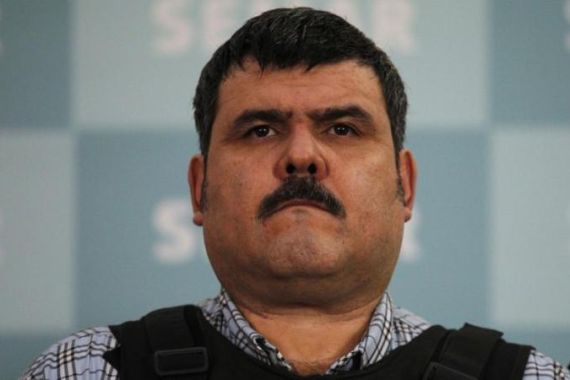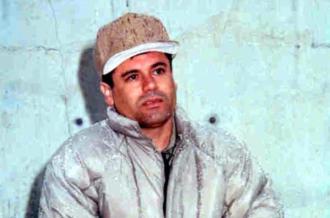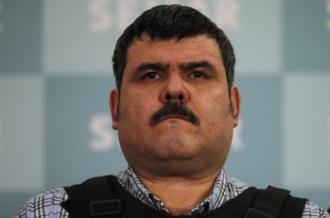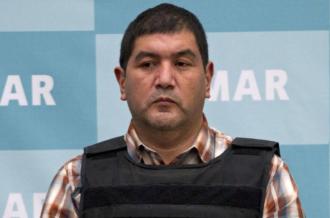Mexico’s top drug kingpins
A quick look at some of the country’s most prominent traffickers behind the ongoing deadly turf war between the cartels

As Mexico’s President Felipe Calderon continues to crack down on organised crime in Mexico, the country’s drug kingpins are fighting a turf war in which at least 60,000 have died since 2006.
The Mexican navy has recently arrested a number of prominent drug lords, who were paraded in public. However, Joaquin Guzman, the leader of the infamous Sinaloa drug cartel, remains at large after his escape from prison.
| Joaquin ‘Shorty’ Guzman |
 |
|
Joaquin Guzman, also known as El Chapo or Shorty for his 1.68m stature is the leader of the Sinaloa drug cartel [Reuters] |
Joaquin Guzman, the leader of Mexico’s Sinaloa drug cartel, is arguably the world’s infamous drug trafficker.
Guzman has built a world-wide empire since he broke out of prison in a laundry van in January 2000.
Known as El Chapo or Shorty for his 1.68m stature, Guzman became Mexico’s top drug lord in 2003 after the arrest of his rival Osiel Cardenas of the Gulf Cartel.
He is now “The most powerful drug trafficker in the world,” according the US treasury.
Guzman’s organisation, the Sinaloa cartel, is named after the Mexican Pacific coast state of Sinaloa where it was initially formed.
Guzman is a “shrewd businessman with a rational mind”, Sylvia Longmire, a drug war expert and former special agent with the the US Air Force, told Al Jazeera.
His group operates “like an old-school Mafia”, she said, unlike the Zetas, who are “psychos running around the country killing people”.
| Jorge Eduardo Costilla “El Coss” Sanchez |
 |
| Jorge Eduardo Costilla ‘El Coss’ Sanchez was the top leader of the Gulf cartel before he was arrested [Reuters] |
Before his arrest in September 2012, Jorge Eduardo Costilla “El Coss” Sanchez, was the top leader of the Gulf cartel and among Mexico’s most-wanted drug lords.
He joined the cartel in the late 1990s after serving as a policeman in Tamaulipas state.
As a lieutenant for the cartel, he started controlling several drug trafficking activities for the organisation.
Sanchez, 41, took control of the Gulf cartel in 2007 along with Antonio Cárdenas Guillén, who was later killed in a gunbattle in November 2010.
When the Zetas separated from the Gulf cartel in 2010, northeastern Mexico was transformed into a “war zone” with near daily gun battles and gruesome assassinations.
Sanchez was arrested in Tamaulipas after the discovery of nine dead bodies displaying signs of torture were found dangling from a bridge in Nuevo Laredo in the same state.
The US state department had offered a bounty of $5m for information leading to his arrest and he was on the Mexican government’s list of the 37 most wanted drug lords.
In November, Toney Tormenta, the new leader of the Gulf Cartel, was killed by security forces in northern Mexico, sparking violence and an exodus of the local population.
| Ivan Velazquez Caballero |
 |
| Ivan Caballero’s nickname El Taliban is a reference the decapitation techniques practised by the Afghan Taliban [AP] |
Ivan Velazquez Caballero, also known as El Taliban, is the former leader of the Los Zetas drug cartel.
The government of Mexico listed Caballero in 2009 as one of its 37 most-wanted drug lords and was offering up to $30 million pesos ($2m) for information leading to his capture.
As a young criminal in his hometown Nuevo Laredo in Tamaulipas, Caballero was arrested for stealing cars and was sent to prison.
Later he became the regional boss of the Zetas cartel in Nuevo Laredo and quickly ascended to the top echelons of the organisation.
During his rise to the top he traded his code name L-50 for the nickname El Taliban, a possible reference the decapitation techniques practised by the Taliban in Afghanistan.
Caballero was arrested by the Mexican navy in September 2012 in the state of San Luis Potosí.
Prior to his arrest, it was reported that Velazquez had split from the Zetas and joined the rival Gulf Cartel, causing a series of massacres and shootings in northern Mexico.
The navy paraded Caballero, 42, before the media, cuffed and flanked by masked soldiers carrying assault rifles, bundles of money, weapons and seized drugs were laid out on a table in front of him for a customary photo opportunity.
| Edgar Valdez Villareal |
 |
| Edgar Valdez Villarreal’s nickname, Barbie, was given to him by his football coach, who compared him to a Ken doll [AFP] |
Edgar Valdez Villareal, nicknamed “The Barbie, is a Mexican-American drug trafficker who was arrested in August 2010.
Facing trafficking charges in the US, Villareal, 37, has been blamed for a vicious turf war that has included bodies hung from bridges and shootouts in central Mexico.
Federal police caught Villareal, the Texas-born leader of the Beltran Leyva gang based in central Mexico, in a house in a residential area on the edge of the state of Morelos, near Mexico City.
He was one of the most sought after drug lords by authorities in both Mexico and the US.
His arrest was the culmination of a yearlong intelligence operation.
US authorities had put up a $2m reward for information leading to Villareal’s arrest.
Villareal’s nickname, Barbie, was given to him by his high school American football coach, who compared him to a Ken doll due to his green eyes and facial features.
The capture of Villareal – the third major drug lord brought down by Mexico’s security forces in less than a year – came on the heels of the killing by Mexican soldiers of another drug boss, Ignacio “Nacho” Coronel, in July 2010.